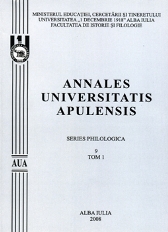A Systemic Functional Classification of Adjuncts
A Systemic Functional Classification of Adjuncts
Author(s): Madalina CerbanSubject(s): Language and Literature Studies
Published by: Universitatea »1 Decembrie 1918« Alba Iulia
Keywords: adjuncts; circumstantial; moda; conjunctive; classification
Summary/Abstract: The paper discusses the structure and function of adjuncts as an important optional part of the clause within the systemic functional framework. We can identify three subtypes of Adjuncts corresponding more or less to the three macrofunctions: experiential, textual and interpersonal. These subtypes are: (i) circumstantial, which conveys information about the circumstances of a process, e.g. time, place, manner, the associated participants; (ii) modal, which indicates the speaker’s/ writer’s attitude towards the message or the comment of its relevance, reliability and so on; (iii) conjunctive, which functions as links between clauses. We also present some problems in distinguishing among these subtypes of adjuncts. A difficult case is represented by the phrasal verbs that, in terms of the content, function as a single unit. Another problem is represented by the identification of the Adjuncts and Complements. The Complement is a complementary role to the Subject, having the status of a ‘potential Subject’ which can be realized by passivization. Beside the situations in which it is difficult to identify the correct type of adjunct, there are also some situations in which it is difficult to separate conjunctive adjuncts from the conjunctions. As their name suggests, conjunctive conjuncts have a function similar to that carried out by conjunctions; they signal the rhetorical organization of the text, which places them as part of the textual metafunction and this is why conjunctives and conjunctive adjuncts can be mixed out.
Journal: Annales Universitatis Apulensis. Series Philologica
- Issue Year: 9/2008
- Issue No: 2
- Page Range: 173-178
- Page Count: 6
- Language: English

